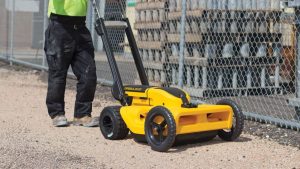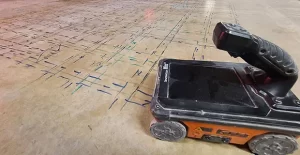Ground Penetrating Radar (GPR) technology has become indispensable in the utility locating industry.
While both large and small GPR units offer unique advantages, they come with specific limitations.
In this review, we’ll assess the advantages and disadvantages of using large and small GPR units for utility locating.

Large Ground Geophysical
Large Ground Geophysical Radar (GPR) units offer advantages for utility locating, with their exceptional depth penetration capabilities, reaching depths of 10 to 20 meters, making them valuable for locating buried utilities.
Advantages:
- Greater Depth Penetration: Large GPR units are well-regarded for their ability to probe subsurface structures at significant depths, typically ranging from 10 to 20 meters. This makes them invaluable for locating utilities buried deep within the earth.
- Comprehensive Data: Their capacity to reach greater depths results in more comprehensive data acquisition. This, in turn, provides utility locators with a more detailed understanding of subsurface conditions.
- Geological and Environmental Applications: Large GPR units are preferred for geological and environmental applications, allowing professionals to explore the Earth’s history and assess geological conditions.
Disadvantages:
- Size and Mobility: The large size of these GPR units can be a drawback when maneuvering in tight or congested workspaces. Their portability is limited compared to smaller units.
- Complexity: Operating large GPR units often demands more specialized training, increasing the learning curve for professionals.
They provide comprehensive data, enhancing the understanding of subsurface conditions. These units also find applications in geological and environmental studies.
However, their disadvantages include their size, limiting mobility in tight spaces, and their complexity, demanding specialized training.
Despite these limitations, large GPR units remain crucial for in-depth utility locating and geological assessments, balancing their downsides with their substantial benefits in comprehensive subsurface exploration.

Small Handheld Concrete GPR:
Small Ground Penetrating Radar (GPR) units are highly portable, making them perfect for mobile utility locating tasks. They excel in shallow depth investigations, ideal for concrete scanning, allowing professionals to detect buried pipes and rebar within structures, preventing potential damage.
Advantages:
- Portability: Small GPR units are compact and highly portable, making them ideal for quick, on-the-go utility locating tasks. They are easier to transport to various job sites.
- Concrete Scanning: Their design is tailored for shallower depth investigations, typically up to 1 meter. This makes them perfect for concrete scanning, allowing utility locators to detect pipes, cables, and rebar hidden within structures.
- User-Friendly: Smaller GPR units are generally easier to operate, requiring less extensive training, which is advantageous for utility locators and construction professionals who need immediate results.
These small GPR units are user-friendly, requiring minimal training, enabling utility locators and construction experts to achieve quick and precise results.
Their portability, suitability for shallow-depth work, and ease of operation make them a valuable asset in utility locating, ensuring mobility, accuracy, and efficiency on various job sites.
Disadvantages:
- Limited Depth: The primary drawback of small GPR units is their limited depth of penetration, typically around 1 meter. This makes them less suitable for projects requiring the location of utilities buried at greater depths.
- Simplified Data: The data output from small GPR units is often simpler, which can be seen as a disadvantage for projects that require detailed and complex data interpretation.
Choosing the Right GPR Unit:
When selecting between large and small GPR units, consider the following factors.
- Depth Requirements: Assess the depth at which utilities need to be located. Large GPR units are better for deeper subsurface exploration, while small units are ideal for shallow investigations.
- Portability: Evaluate the ease of transporting the equipment to different job sites. Small GPR units offer greater mobility.
- Data Complexity: Consider the complexity of the data you need. For intricate and comprehensive data, large GPR units are more suitable, whereas small units are more user-friendly for straightforward results.
In conclusion, the choice between large and small GPR units should be guided by the specific needs of your utility locating project.
While large GPR units are adept at exploring significant depths and offering intricate data, small GPR units excel in portability and quick results.
The key is to match the GPR tool to the depth and data requirements of your project to ensure efficient and accurate utility locating.
